 |
We met up with Marty, who explained that the Will Call line for picking up tickets stretched through the convention center and into the street and down the block… and the convention center covers a full city block. We decided we would do dinner and then circle back at 9 pm.
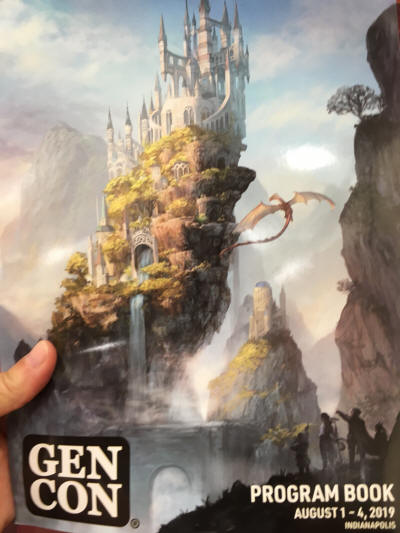 |
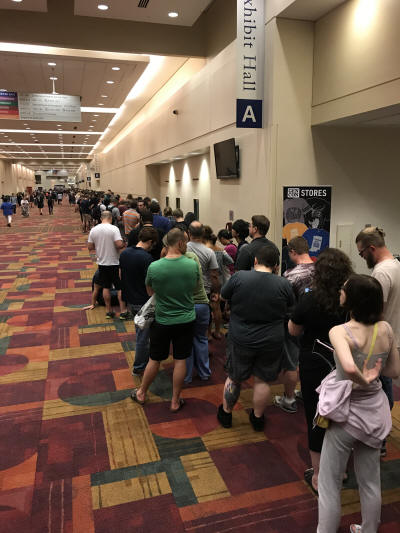 |
By then, the line had shrunk to… actually, it was just as long. We decided to try Thursday morning instead. Arriving about 9, we were happy to see that the line was just a tad longer than the entire length of the convention center, but wasn’t actually out the door into the street. Despite our fears, it moved quickly and it was only a little less than an hour before we reached the will call booth and picked up our passes.
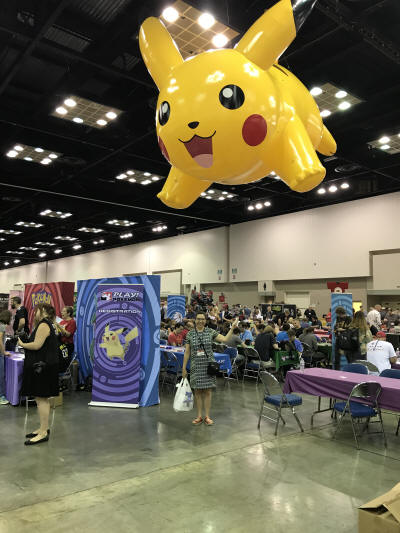 |
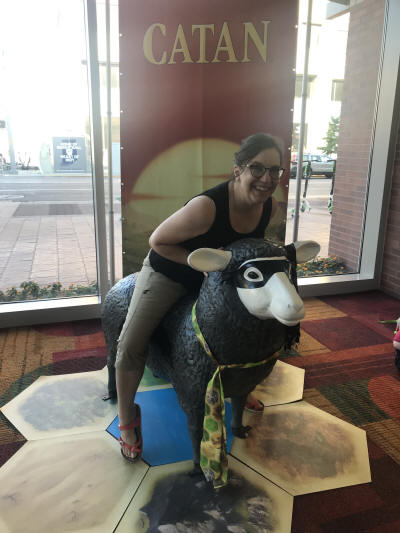 |
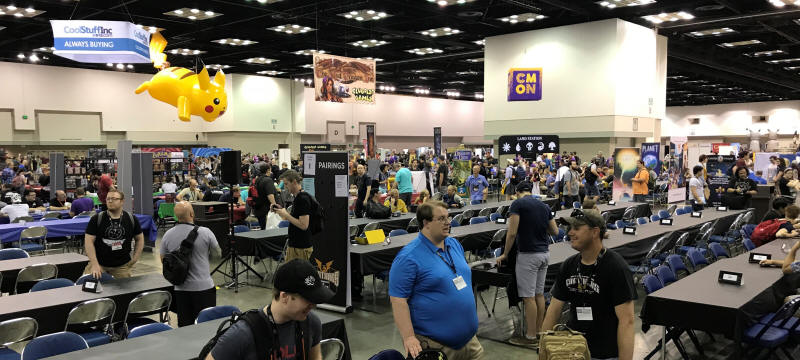
Gencon this year, like every year, was a little different. The exhibit hall, where the vendors set up, had blown out into the area that was the Magic the Gathering area, making it at least half again as large as it was two years ago. The distance between vendors seemed a little larger, but mostly it was full of a new generation of game companies with a handful of games and dreams of being the next Settlers of Catan. The miniatures tables were a scattered throughout the convention instead of concentrating in Hall A, and there were a surprising large number of them, along with new miniatures games and associated vendor booths. The Lucas Oil Stadium was open and full of vendor tables-blocks for demos. The upstairs was still the land of miniatures painting and Pathfinder (the D&D alternate RPG that has been extremely popular). It was still crowded, but didn’t feel as cheek-to-cheek as two years ago, and while some of the more in-demand vendors had aisles crowded enough that you had to zombie-shuffle through them, there were enough that were more open that it didn’t become an hour-long event to get through the exhibition hall. Cosplay was not as prevalent as at Anime conventions, and was sparse Thursday and Friday, but was out in force on Saturday.
| Eric and Marty |
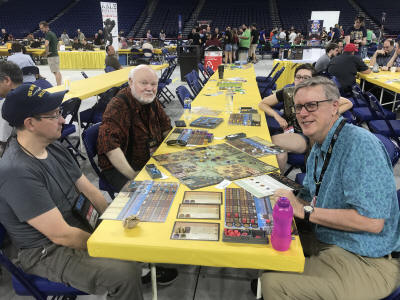 |
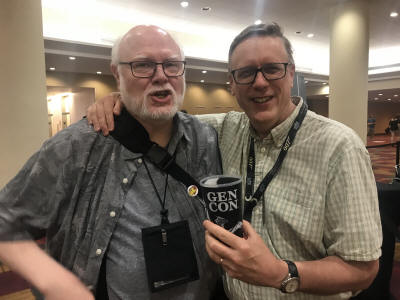 |
Cosplayers
 |
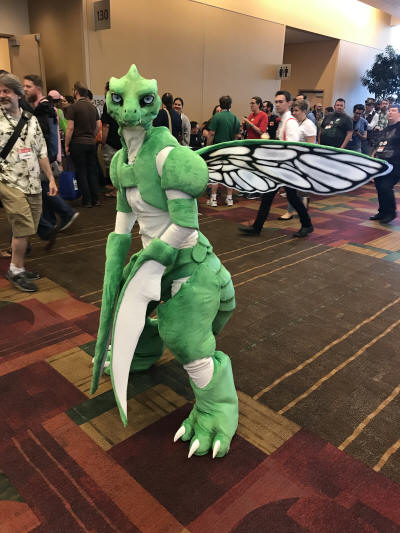 |
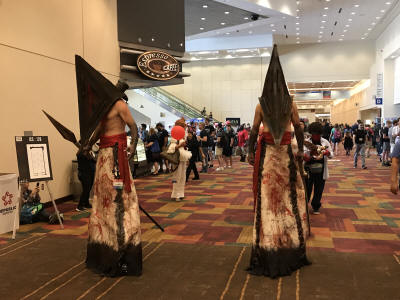 |
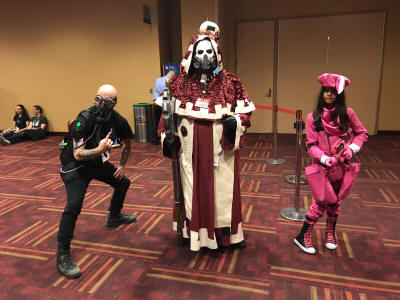 |
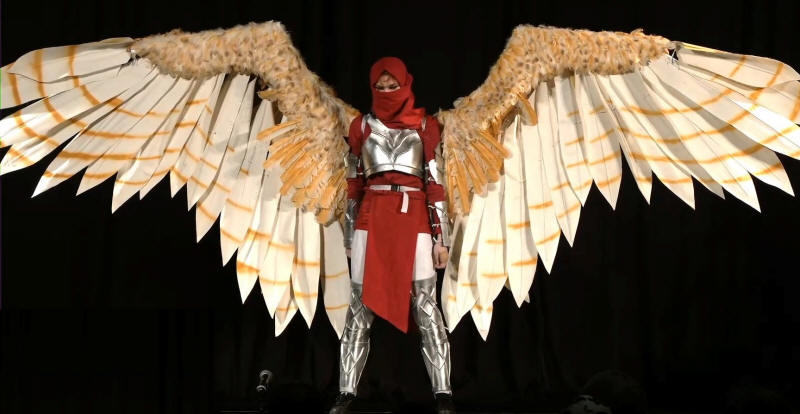
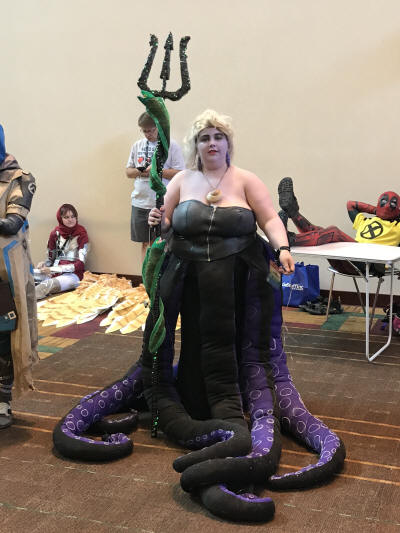 |
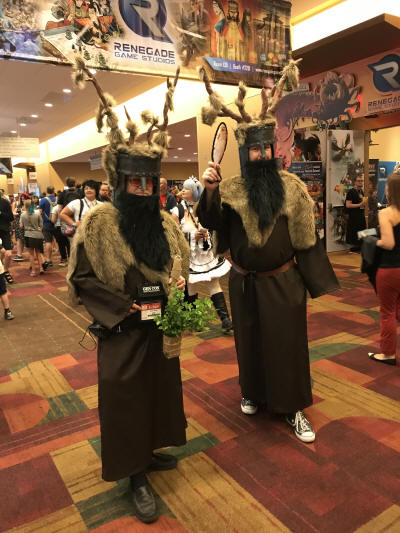 |
Miniatures
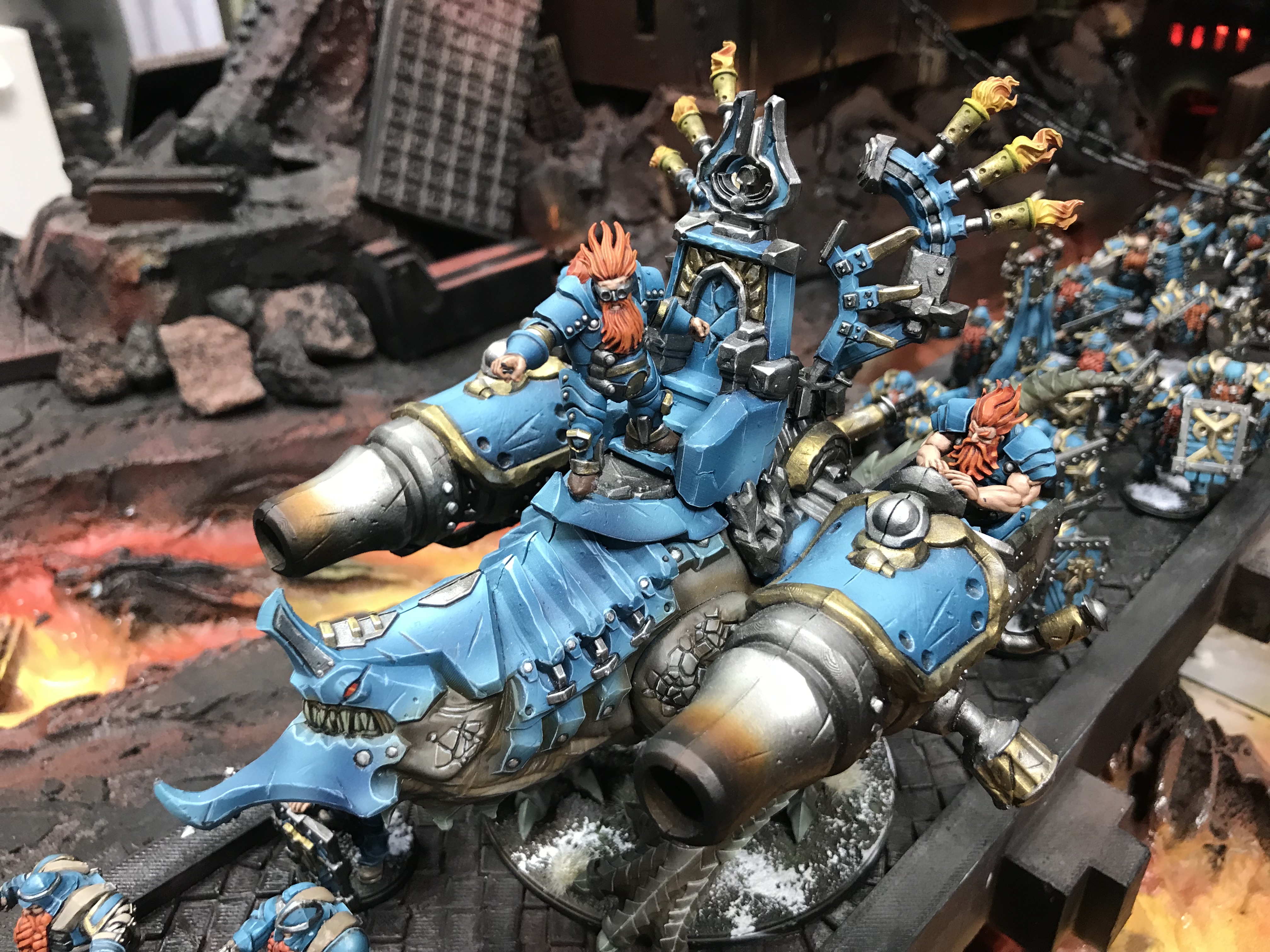 |
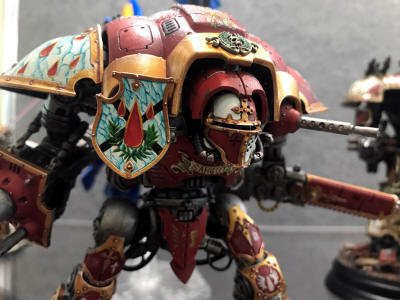 |
 |
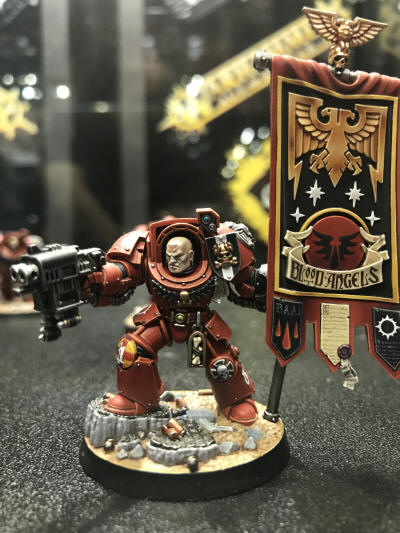 |
Alison opted out of most of the activities, although we did finally purchase a piece of original art from a painter she liked. Instead, she toured the Indianapolis area, which turns out to have a fair number of museums and other points of interest (like the old courthouse and the central canal). That included the unpronounceable Eiteljorg Museum as well as Eugene and Marilyn Glick Indiana History Center.
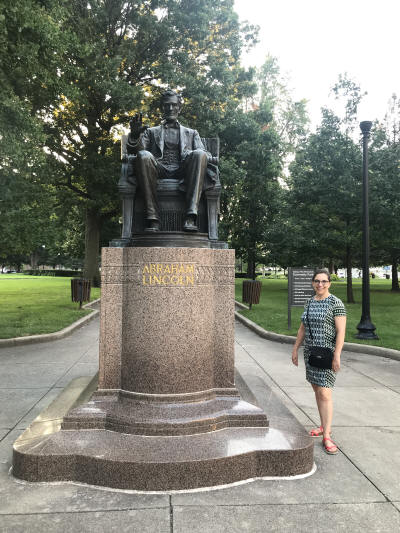 |
|
|
|
The original painting we purchased
 |
Here’s the rundown on the games I played.
Endeavor: Age Of Sail: Good territory control
game with a balanced set of abilities you need to advance; you need all
of them so you are looking for the break points that let you finesse
something, like play a card that gets you a resource that advances the
number of cards you can hold so that you don’t have to discard it. A few
variations on the path to victory, but I would put it more in the
tactical category than strategic. It felt a lot like Mac Gurdts’
Navegator, a game I like a lot, althought Navegator has more of an
engine building aspect to it for victory points; this game forced even
progression most of the time. Buy, except I think I’d rather play
Navegator, so I probably won’t.
Hadara: A colorful card chaining game with a few special
scoring rules. Pretty, but nothing special. Pass.
Ishtar: An area control game with beautiful art and high
production value; I played one round, which wasn’t enough to totally get
the game (it was number one in the BoardGameGeek “the hotness” ranking,
which meant everyone wanted to play it). You place oddly shaped
boards over a larger board that has different kind of terrain; some you
have to play next too (wells), some you can’t cover (shrines), and some
have gems. The boards have flower beds and grass; you want to control
contiguous flower beds. Place over gems, you get the gems, which
lets you do special actions, including connecting flower beds (as long
as it doesn’t merge with someone else’s). It seemed fun; it’s not out in
general distribution, so I bought a copy.
Mechanica: This one was pretty unique; you have a board that represents a factory floor that produces roombas, the little robotic vacuum cleaner, in three different models. You bid on tiles that improve the factory floor, like upgraders, duplicators, and the like to improve output and model type; they can chain together to improve production even more. You can use the money you make for those upgrades, or to buy "blueprints" that are worth a lot of points at the end (plans for warbots and orbital mind control satellites). Interesting mechanics, but we played through once and it's not clear to me it's a good game. Pass.
Raccoon Tycoon: A fairly standard resource gathering game
with auction/bid based economics built in, but with the special
expansion pack you could score at Gencon, it becomes a six player game,
which is rare for those types of games. I bought it.
Villainous: A Disney-villain themed mostly-card came
(each player has a board with “regions” that allow you to do certain
actions, and restrict where battles and things occur, but most of the
action was with the cards). Cute, and it was entertaining that
each villain had different kinds of actions and theme-appropriate
winning conditions (As Scar, I had to kill Mufasa, then a number of
other heros, like Nala and Simba). But it was a terrible game, with
repetitive, mindless game play and little player interaction (and even
that was random; you had one action you could use against other players
but sometimes it helped them instead of hurting them). Pass.
Rail Pass: A frantic rail-themed co-op game where you
have a set of cubes that must be delivered to other players (and a set
that needs to be delivered to you) by passing cube-carrying trains, with
a few rules about how to do it; you could use both hands, and had
“landing spaces” for one long and one short train; you could only
offload your own color cubes from a landing space, and you had to have a
free had to do it; you picked cubes off a track in a random order, no
cherry picking; trains couldn’t move more than one space from their
origin unless you changed out a “conductor,” which took a hand; etc.
It was a frantic six minutes and kind of fun but I can’t imagine you
would play it more than a few times. Pass
Tiny Towns: A pattern matching game. You have a
grid. You can place different kinds of resources (that each player in
turn calls) in each square, one per square. Certain patterns can
then be harvested to create buildings that can be on any square that
contained one of the resources you needed to build it. Different
buildings had different scoring criteria. It was easy to jam up your
board in a way that made it impossible to build, and any square (when
you could no longer place anything) counts as negative points. It
was enjoyable and the mechanism was new, but I’m not a big fan of
pattern matching games so it fell a little short for me. Pass unless you
like Carcassonne and variants.
Anomaly: I didn’t actually play this, and I only mention
it in passing because it was a beautiful game with interesting
hidden-movement mechanics and the people playing it seemed to be having
fun. I might buy this if it gets rated highly on BoardGameGeek.
Ship Shape: This was a fun, short game with bidding and
tile placement; the twist is that the tiles are partially filled in
grids that lie on top of each other, so you can cover up “bad” things
while increasing three different scoring paths (gold is straight victory
points, cannons are the same, but minus the lowest number scored by a
player, so if you have eight and they have four you get four points and
they get zero, and contraband, where the highest number player gets
nothing and everyone else scores). It was simple and fun and sold
out. Buy.
Mission: X-code: Another co-op game (I was with Eric, it wasn’t my
fault). Pass cards around in proscribed directions in order to
allow players to collect sets of three numbers; place sets of three on a
telephone keypad. When you’ve covered all the numbers (and the
pound sign and asterisk) you’ve won. It was fine if you like that sort
of thing, which I don’t. Pass.
The Artemis Project: A dice rolling / worker placement
(well, dice and worker placement, you played dice to get people to
place) game with a bidding mechanic. It looked reasonably interesting
and it was high up in the BoardGameGeek “gencon hotness” ranking.
Just had a walkthrough rather than playing it, but it looked good enough
that I panicked and bought it (“there are ONLY FOUR left, if you want
the more expensive kickstarter version with the DICE CUP and GOLDEN
MEEPLE of INCREDIBLE VALUENESS!)
Imhotep: The Duel: Imhotep is a multiplayer game (that
also looks interesting but which we did not try); the Duel is a modified
version of the game made for two players. It’s tick tack toe for
resources; you place meeples on a 3x3 grid as does your opponent in
turn; at some point instead of placing, you pick up resources along the
column or row you choose and the three resources along each are
distributed based on which player is in which grid. Resources
combine in different ways for victory points with different multipliers
(some are just “collect sets,” some are “collect sequences,” and that
kind of thing). You have to pay as much attention to keeping your
opponent from getting points as you do getting your own. We were going
to purchase this but decided to try it out first, and by the time we
circled back all the copies were sold. Bought it on Amazon.
Lovelace and Babbage: Do timed math with quirky rules to
collect random symbols that score points if you have the most.
Frantic and very focused, which means you don’t want to be drinking if
you’re playing the game, which rules it out for me. Pass (but Eric
bought it).